
Introduction
In the past we have reviewed a wide range of
monitors, from a wide range of different manufacturers. This has included some
high end professional grade screens as well, for example from NEC and their
SpectraView range. We have had a lot of reader feedback asking for reviews of
Eizo monitors as well. While these are again high end and quite niche models,
they offer an impressive range of features and some interesting things for us
to test and evaluate. We hope in the future to feature more Eizo reviews, and
we wanted to start with their 27" FlexScan SX2762W screen here. The SX2762W is
an alternative to models such as the
NEC PA271W,
NEC SpectraView Reference 271 (a.k.a. NEC PA271W-SV) and the more mainstream
Dell U2711. Like those other models the Eizo offers a wide colour gamut,
and features the more traditional CCFL backlighting technology as opposed
to the currently popular W-LED backlighting. It offers a whole host of
interesting and high end features including support for hardware level
calibration, a 16-bit Look Up Table (LUT), '10-bit' panel, uniformity correction technologies and several
features aimed at power saving and more comfortable user experiences. We will test
these throughout the course of the review.
Eizo's website states: "Featuring an
impressive 27-inch screen, wide colour gamut, and hardware calibration
capability with the optional EIZO EasyPIX colour matching tool, the FlexScan
SX2762W makes it easy for professionals in graphic design, digital
photography, CAD/CAM, and DTP to get predictable colour results."


Specifications and Features
The following table gives detailed information
about the specs of the screen:
|
Monitor
Specifications |
|
Size |
27"WS (68 cm) |
Panel Coating |
Anti-glare (matte) |
|
Aspect Ratio |
16:9 |
Design
colour |
Black matte plastic bezel, stand and base |
|
Resolution |
2560 x 1440 |
|
Pixel Pitch |
0.2331 mm |
Interfaces |
Dual-link DVI, DisplayPort, Mini DisplayPort
(HDCP supported) |
|
Response Time |
6ms G2G |
Ergonomics |
Tilt, height, swivel and rotate |
|
Static Contrast Ratio |
850:1 |
|
Dynamic Contrast Ratio |
n/a |
VESA Compatible |
Yes 100 x 100mm |
|
Brightness |
270 |
Accessories |
DL-DVI cable, power cable, USB cable |
|
Viewing Angles |
178/178 |
|
Panel Technology |
IPS |
Weight |
With stand: 13.6Kg |
|
Backlight Technology |
WCG-CCFL |
Physical Dimensions
|
(WxHxD with stand, and height range shown)
646 x 425 ~ 576.5 x 281.5 mm |
|
Colour Depth |
1.07 billion (8-bit + AFRC)
from palette of 278 trillion |
|
Colour Gamut |
Wide
gamut
102% NTSC, 97.1% Adobe RGB, 100% sRGB |
Special
Features |
hardware programmable 16-bit LUT, 2x
USB ports, brightness stabilization, digital uniformity equalizer (DUE), auto
EcoView ambient light sensor, EcoView Sense - human sensor |
The SX2762W offers a decent enough set of
interface connections. It has a Dual-link DVI connection which allows you to run
the screen at its full 2560 x 1440 resolution providing you have a compatible
graphics card. The dual-link DVI cable is provided as well in the box. There are
also two DisplayPort connections here, one is a normal size and the other is a
Mini DisplayPort which is very useful for connecting Apple Mac machines. The two
DisplayPort connections are listed by Eizo as supporting HDCP for encrypted
content, but oddly they do not mention support over DVI. According to the NVIDIA
control panel on our test machine, the DVI connection is HDCP certified as well.
Eizo have opted not to provide connections for D-sub (VGA) or HDMI here which
are perhaps a little missed. Those connections cannot support the full 2560 x
1440 resolution due to bandwidth restrictions, and so presumably one of the
reasons they have been omitted, along with the fact this screen is not really
aimed at multimedia users. It would have been nice to see them included though I
think in case you needed to connect an external device, even if you then let the
screen interpolate and scale the image, or just used the built in aspect ratio control to put
borders around the image.
There are 2x USB ports provided on the underside
of the back of the screen which are useful for connection of external devices.
It might have been good to have a couple available on the side of the screen as
well for easy connection of devices, such as the calibration equipment you will
probably want to use with a screen like this. There are no speakers or audio
connections on the screen. It does however offer some high end features which we
have already mentioned. There is a 16-bit hardware programmable LUT for
calibration, a digital uniformity correction technology like NEC's ColorComp
which is called Digital Uniformity Equalizer (DUE), an ambient light sensor
(Auto EcoView) and a human sensor (EcoView Sense).
Below is a summary of the features and connections of
the screen:
|
Feature |
Yes / No |
Feature |
Yes / No |
|
Tilt adjust |
 |
DVI |
 |
|
Height adjust |
 |
HDMI |
 |
|
Swivel adjust |
 |
D-sub |
 |
|
Rotate adjust |
 |
DisplayPort |
 |
|
VESA compliant |
 |
Component |
 |
|
USB Ports |
 |
Composite |
 |
|
Card Reader |
 |
Audio connection |
 |
|
Ambient Light Sensor |
 |
HDCP Support |
 |
|
Touch Screen |
 |
Integrated Speakers |
 |
|
Hardware calibration |
 |
Uniformity correction |
 |

Design and Ergonomics
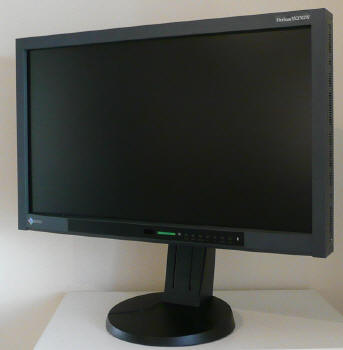
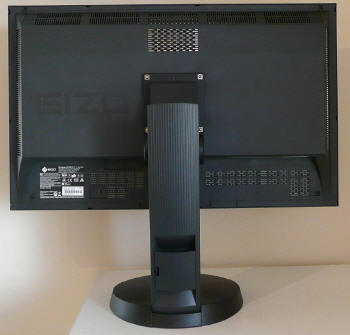
Above:
front and rear views of the screen. Click for larger versions
The Eizo SX2762W comes in an all black design.
The plastics are almost entirely a matte finish, apart from a strip along the
bottom bezel which is a glossy finish. The section contains the EcoView
sensors and the OSD operational buttons. In the top right hand corner of the
screen there is a removable 'FlexScan SX2762W' sticker in a silver finish. The
bezel around the panel is fairly thick and it measures 22mm along the sides, 26mm
at the top and 35mm along the bottom. The panel itself is also inset quite a
lot, with the bezel protruding outwards towards the user by ~8mm along the top
and sides, and by up to 16mm along the bottom edge of the panel. The sides of
the screen is squared off along the edges apart from at the bottom where the
bezel curves away along the lower edge. Because of this thick chunky bezel the
screen does look quite blocky and 'industrial' from head on.
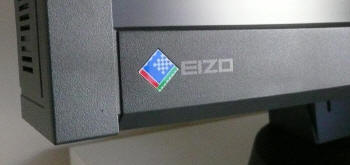
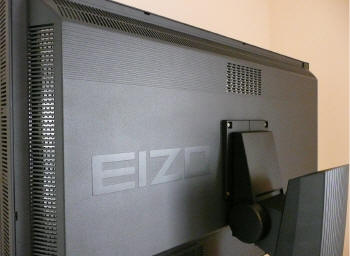
Above: view
of Eizo logo on front bezel and back. Click for larger versions
There is an Eizo logo on the bottom left hand
corner of the bezel. From the above photo you can see where the bezel curves
away along the lower edge. The back of the screen is pretty flat and
squared off. There is a large Eizo logo etched into the plastic back as well.
There are various grills along the edges of the screen to allow for heat
dissipation. There is also a grill in the middle of the back of the screen,
just above the stand. If you look closely (not on this picture) you can see
there is actually a small fan visible behind this section to help with keeping
the screen cool. We will explore this a bit more shortly.
The stand connects through 4 screws on the back
of the screen which is also VESA 100mm compatible if you want. If you do
decide to mount this screen in any way you will need a very sturdy mount / arm
since the screen is very heavy (9.7Kg without the stand).

Above: OSD
operational buttons. Click for larger version
The bottom right hand portion of the lower bezel
features the OSD operational buttons which we will
talk about shortly. You
will spot on the left hand side the 'Auto EcoView' sensor which detects
ambient lighting conditions and adjusts the brightness of the display
accordingly. At the right hand end is a small rectangular power LED which
glows blue during normal operation. You can control the intensity of this LED
in the OSD menu as well if you want. In standby this glows orange.
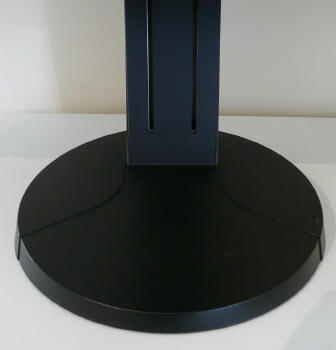
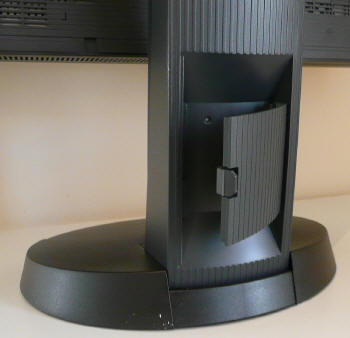
Above: base
of the stand and cable tidy. Click for larger versions
The base of the stand is a chunky but balanced
round plastic bottom with a thick and heavy duty arm connecting up to the back
of the screen. Overall it gives it a level and sturdy support which is good.
On the back of the monitor arm is a small click-shutting door as shown above
which allows you to tuck the cables nicely out of the way.
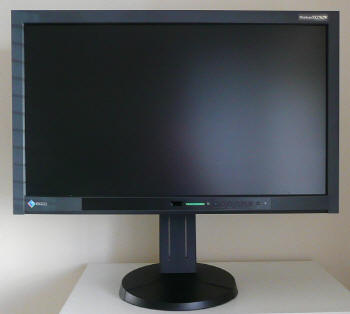
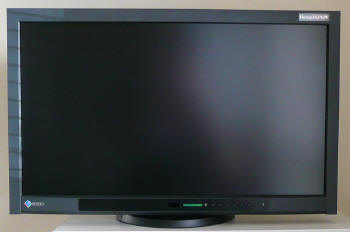
Above:
maximum and minimum height adjustment shown. Click for larger versions
There is a wide range of ergonomic adjustments
available from the stand. Above shows the maximum and minimum height of the
screen within its specified 151.mm adjustment range. In fact we measured the
bottom of the screen as being 180mm above the height of the desk at maximum
height, and only 20mm when at its minimum. So it appears the adjustment range
is slightly more at 160mm in total. At the lowest setting the screen is very
low to the level of the desk as you can see but this does afford the user a
very good range of movement which is nice to see. The movement itself is
smooth but quite stiff, mainly because it needs to be to hold the weight of
the screen. It's easy enough to re-position though.
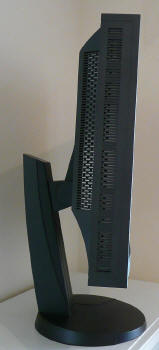
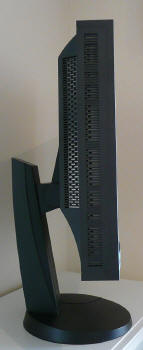
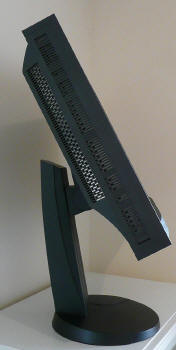
Above: full
range of tilt adjustment and side profile shown. Click for larger versions
There is a decent tilt range available from the
screen as well, both forward and backward. The range is shown above, and its
fairly easy to re-position the screen. As you do so, the movement is smooth
and sturdy. As you can see from these side views the profile of the screen is
also very thick at 281.5mm (with the stand) according to the spec. The SX2762W
uses CCFL backlighting, has an integrated power supply and also features a
whole host of internal electronics which all add to the thickness of the screen.
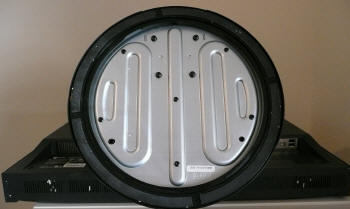
Above: view
of base of the screen. Click for larger versions
There is also a very wide side to side pivot /
swivel adjustment range available. There is actually a thin black section on the bottom of the
stand shown above which makes contact with the desk, and then rotates within
the main body of the base to produce a very easy to use side to side swivel.
It is smooth on the most part and offers almost a full 360° rotation. In fact
it can swivel 172° either side - you just need to make sure the rotating
"disc" is in a central point to start with as you sit it on your desk.
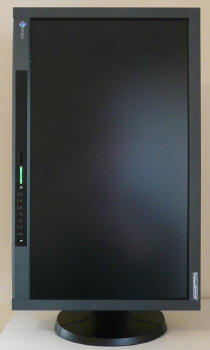
Above:
rotated portrait view. Click for larger versions
The SX2762W also offers a rotation function to
switch between landscape and portrait views. While this is smooth and fairly
easy to re-position, its value and practical use on such a big screen is
probably questionable. Still it's there if you need it and like the
functionality.
New Cabinet and Stand Design
|
The FlexScan SX2762W features a new cabinet and is the first monitor with
the new FlexStand 2. The cabinet design maintains the distinct look of
EIZO monitors while introducing a more smoothly rounded appearance. The
FlexStand 2 complements the new cabinet design while offering very
versatile positioning with 152 mm height adjustment, 25° tilt, 344°
swivel, and 90° rotation for portrait mode viewing.
Video
courtesy of Eizo.com |
A summary of the screens ergonomic adjustments
is shown below:
|
Function |
Range |
Smoothness |
Ease of Use |
|
Tilt |
Good |
Smooth |
Fairly easy |
|
Height |
~160mm |
Smooth |
Fairly easy, but heavy |
|
Swivel |
172° / 172° |
Fairly smooth |
Very easy |
|
Rotate |
Full |
Smooth |
Fairly easy |
|
Overall |
Excellent range of adjustments and all
pretty smooth. Some are a little heavy to adjust due to size and weight of
screen. |
The underside of the back of the screen features
the various interface connections available.


Above:
interface connections (top) and power connection (bottom). Click for larger
versions
The top image shows the DL-DVI connection,
DisplayPort, mini DisplayPort, upstream USB and 2x downstream USB ports. The
bottom image shows the power connection along with an on/off switch. The
screen features an integrated power supply so you only need a normal kettle
lead cable (provided) to power the screen.
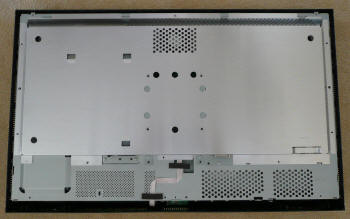
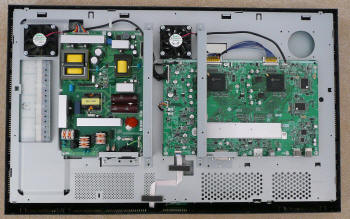
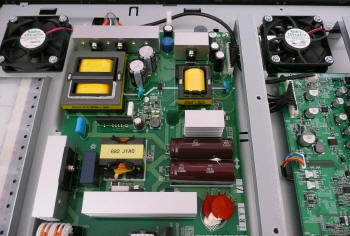
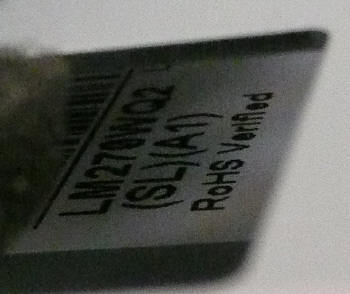
Above:
dismantled views of the screen showing internal electronics, and cooling
fans. Click for larger versions
As we mentioned a bit earlier there are quite a
few grills on the back and sides of the screen to help with heat dissipation
and we could even see a small fan behind the central grill. We popped the back
off the screen after removing a few screws to get a closer look. At first (top
left image) you will see there is a metal enclosure over the components for
protection. Removing that metal plate (top right) exposes the internal
electronics and circuit boards. You can see there are actually two small fans
connected to the screen which are there to try and keep it cool. In fact they
do a pretty good job and the screen is only moderately warm to the touch at the top
and sides after prolonged use. However, with the presence of these fans, there
is of course some associated noise. Not a problem in an office I'm sure, but
home users who are in to their ultra-quiet set ups need to consider this. They
were pretty quiet though and I couldn't really pick them out over my graphics
card and power supply fans from our test PC unless I moved my head very close
to the screen. The bottom right hand picture also confirms the panel part
being used here is the LG.Display LM270WQ2-SLA1. This was just visible beneath
another metal section which we did not remove as it was unnecessary.

The materials used are of a good standard and
build quality feels very good, if a little bulky and heavy. It feels a bit
industrial but should be very robust for long term use. The screen coating is a
traditional anti-glare (AG) solution. Like other modern IPS panels the coating
is pretty aggressive and so does give a grainy feel to light / white images. If
this is something that bothers you, you may want to look for a glossy solution
of one with a lighter AG coating such as some AMVA and PLS based screens.
|
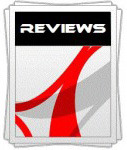 |
This review had been made available to
download and save
in PDF format (.pdf) allowing you to:
-
Save a copy for personal use and
archiving
-
Save and read our reviews offline
-
Read our reviews on your eBook
reader (e.g. Kindle, iPad and other tablets)
Please
visit our Store
for more information and to download a copy. A small fee will contribute
towards the running of TFTCentral and allow us to continue to make high
quality and detailed reviews in the future. |

OSD Menu

Above: OSD
operational buttons. Click for larger version
The SX2762W is controlled by a set of 7 buttons
which are located in the right hand portion of the lower bezel and are
labelled with a subtle grey font as shown. There is quick launch access to
control the input selection (signal button) which switches quickly and easily
between DVI, DisplayPort and Mini DisplayPort. A graphic on the screen helps
confirm which you have selected.
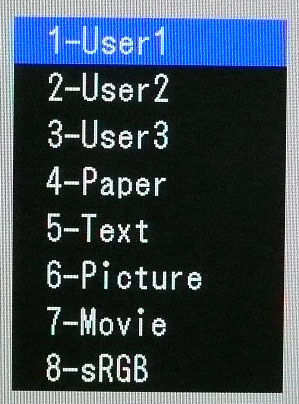
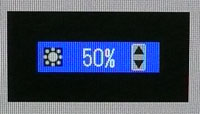
The 'mode' button gives you quick access to the
8 preset modes on the screen which pops up a small menu in the bottom left
hand corner as shown above. There are 3 user defined preset modes available as
well as Eizo configured options for paper, text, picture, movie and sRGB.
The up and down arrow buttons give you quick access to the brightness control
which pops up in a small box as shown above. This can be easily changed in 1%
steps between 0 and 100%. The 'enter' button brings up the main OSD menu and
on the far right is the power button.
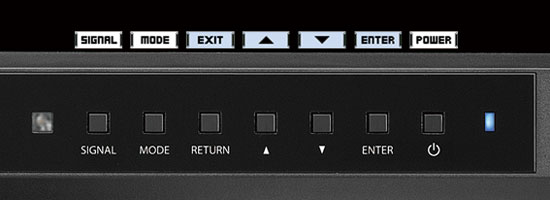
Above: OSD menu guide to button operation
The 'return' button doesn't offer any quick
launch access but instead pops up a small guide at the bottom of the screen
telling you which each button would do. In fact this guide stays in place
while you use the main OSD, telling you what each button would do depending on
where you are in the menu and how far you have drilled in. This makes it
pretty easy to use and offers a decent level of assistance as you navigate.
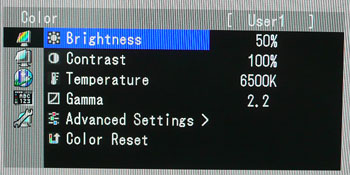
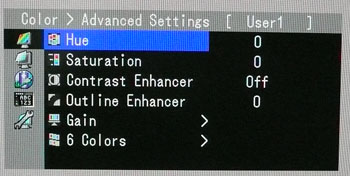
The main OSD is split into 5 sections which are
labelled with different icons running vertically along the left hand side of
the photos above. The first section is the 'color' menu which gives you the
usual access to brightness and contrast. There are also options for colour
temperature and gamma which are useful. Drilling into the 'advanced settings'
section brings up the menu on the right above, giving you further control over
the image including hue and saturation controls.
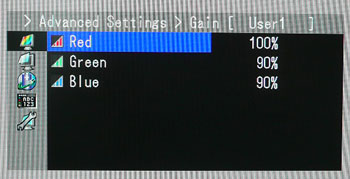
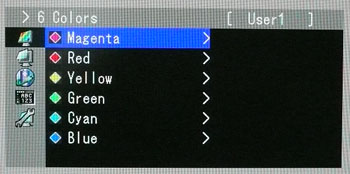
Drilling further into the colour controls takes
you into the 'gain' section where you can control the RGB levels. The '6
colors' menu gives you control of hue and saturation at a 6 colour level for
more finite adjustments. Some of these adjustments are not available in some
preset modes, as defined in the following table:
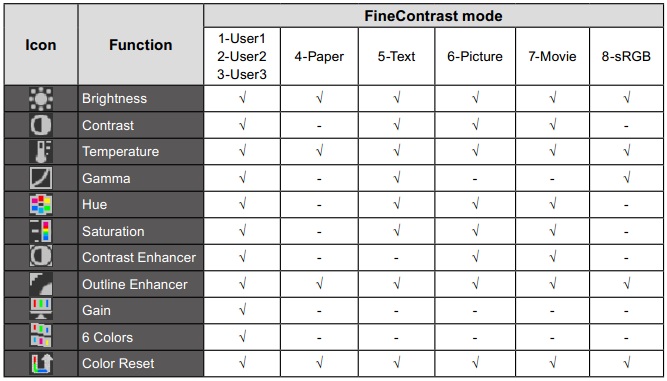
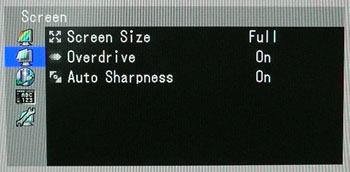
The second section of the OSD is the 'Screen'
menu. This gives you control of a couple of useful features including the
hardware level aspect ratio control and the overdrive function. We will look
at these a little later on
in the review.
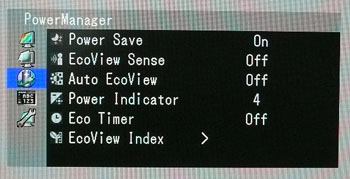
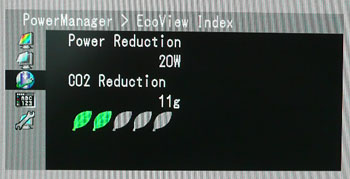
The third section is the 'PowerManager' menu
giving you control over a couple of the advanced power saving features
provided with this screen. You can turn on and off the EcoView Sense (human
sensor) and Auto EcoView (ambient light sensor) here. The EcoView Index
sub-section gives you a bit of detail about your supposed power and CO2
reduction depending on your settings.
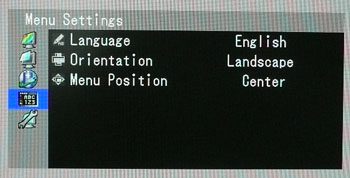
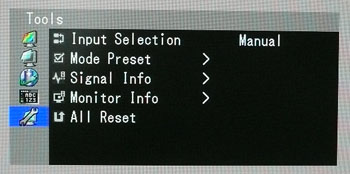
The fourth section gives you control over a few
of the menu settings as shown, and the last 'tools' menu allows you to control
the input selection along with giving you a bit of access to some monitor
information.
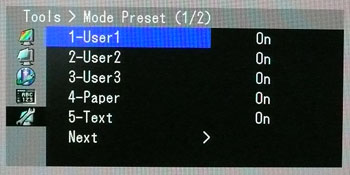
The 'mode preset' sub-section gives you access
to the 8 preset modes as well. You are able to switch automatically between
these presets using the Eizo ScreenManager Pro software as well if you need
to. Overall the menu is pretty intuitive to use and offers a decent range of
options and settings to play with.
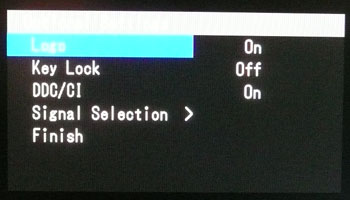
There is
also an "optional settings" hidden menu available which can be accessed
by holding the 'mode' button while powering on the screen and holing the power
button for at least 2 seconds. You can disable the Eizo boot-up logo here if
you want. It doesn't tell you anything about the panel or firmware in this
menu though as some hidden screen menus do.

Power Consumption
In terms of power consumption the manufacturers spec states
a typical usage of 64W and a maximum
usage of <160W during operation. In standby the screen apparently uses <1W.
|
 |
|
State and Brightness
Setting |
Power Usage
(W) |
|
Factory Default (100%) |
140.1 |
|
Calibrated (26%) |
83.6 |
|
Maximum Brightness (100%) |
140.1 |
|
Minimum Brightness (0%) |
59.9 |
|
Standby |
1.3 |
|
We tested this ourselves and found that out of the
box the screen used 140.1W of power while at its default brightness setting
which was at its maximum. Any additional power draw would come from the
connection of additional USB devices. At the lowest brightness setting, power consumption
was reduced to 59.9W. After calibration at a hardware level, where the process
had adjusted the brightness setting to 26%, the screen used 83.6W of power. In standby the screen used
1.3W of power. Overall
the power consumption of this screen was high here due to the use of CCFL
backlighting mainly. This was quite similar power consumption once calibrated to
other CCFL units we have tested including the
Hazro HZ30Wie recently, and NEC's rival the
PA271W /
PA271W-SV.
I have plotted the results of these measurements
on the graph below:

The SX2762W has a few extra features we wanted
to talk about here. Firstly there are the two 'EcoView' technologies provided
with this screen.
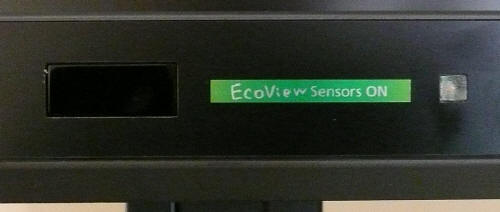
Click for
larger versions. EcoView sensors. Click for larger version
The middle of the lower bezel features a green
"EcoView" label. To the left of this there is a 23 x 9 mm block which is the
'EcoView Sense' sensor. This is designed to detect the presence of a human user and
when they are not using the screen, it can turn it off into power saving mode.
Potentially a useful function for the office environment certainly. To the
right of the label is the 'Auto EcoView' sensor which is an ambient light
sensor, designed to automatically adjust the brightness of the screen
depending on your ambient lighting conditions. Again a pretty useful feature I
think. Below are some videos and some additional information provided by Eizo
about these features:
Presence Sensor for
Power Savings
|
Eizo's EcoView Sense feature unites convenience with energy savings by
ensuring that the monitor automatically conserves power when it is not in
use. EcoView Sense is an integrated presence sensor that prompts the monitor
to switch to power save mode when it does not detect your presence for 70
seconds, and then resume normal operation when you return. To prevent the
screen from reactivating when it shouldn't, EcoView Sense differentiates
between your presence and a still object like an empty chair or general
office activity in the background.
|
Optimized Brightness with
Auto EcoView
|
A sensor on the front of the monitor measures ambient light and optimizes
the screen's brightness to ensure the screen is never too bright or too
dark. If preferred, Auto EcoView can be deactivated in the OSD menu. |
Energy and Environmental Efficiency Index
|
A user-activated EcoView Index displays the level of power savings and
equivalent amount of CO2 reduction compared to using the monitor
without Auto EcoView activated and with the screen set at a brightness of
100%. |
Information
and videos in above table provided by Eizo

Panel and Backlighting
|
Panel Manufacturer |
LG.Display |
Colour Palette |
1.07 billion from 278 trillion (16-bit LUT) |
|
Panel Technology |
H-IPS |
Colour Depth |
8-bit + AFRC |
|
Panel Module |
LM270WQ2-SLA1 |
Colour space |
Wide Gamut |
|
Backlighting Type |
WCG-CCFL
8x CCFL structure |
Colour space coverage (%) |
102% NTSC, 97.1% Adobe RGB, 100% sRGB |
The Eizo SX2762W uses an LG.Display
LM270WQ2-SLA1 H-IPS panel which is capable of producing a colour palette of
1.07 billion colours. The screen is advertised as being able to offer 10-bit
colour depth as a result. Referencing the detailed panel specification sheet
confirms this is in fact using an 8-bit panel with an added Frame Rate Control
(FRC) stage applied which is in keeping with many other competing models. In
fact the NEC PA271W and Dell U2711 we mentioned earlier are also "10-bit", but
use the same LM270WQ2 panel and so also strictly offer 8-bit + AFRC.
It's all very well saying a panel is capable of
10-bit colour depth as opposed to an 8-bit colour depth, but you need to take
into account whether this is practically useable to you, and whether you're ever
going to truly use that colour depth. You need to have a complete 10-bit
end to end workflow in order to make use of this which includes a 10-bit
supporting application, operating system, graphics card and software. This is
still quite rare and reserved really for high end equipment and professional
uses. Nevertheless the 10-bit colour support is there for future uses and for if
you do have the necessary workflow to support it. The use of FRC at the panel
side to simulate this 10-bit colour depth is very common and while it's not a
'true' 10-bit panel, many users (even if they could get a 10-bit end to end
workflow) would not notice a difference in real terms.
The SX2762W also offers a 16-bit internal
programmable Look Up Table (LUT) which means it can offer a 278 trillion colour
palette as well, for optimised grey scale and colour rendering. It also uses wide colour gamut (WCG-CCFL)
backlighting using 8x CCFL tubes, and so the colour space of this screen covers
100% of the sRGB reference and in fact extends considerably beyond this. The
detailed panel specification confirms it can cover 102% of the NTSC colour space
reference and 97.1% of the Adobe RGB space.
PWM Flicker Tests at Various
Backlight Brightness Settings
100%
50%
0%

|
Pulse Width
Modulation Used |
Yes |
|
Cycling
Frequency |
~180Hz |
|
Possible
Flicker at |
|
|
100% Brightness |
No |
|
50% Brightness |
Yes |
|
0% Brightness |
Yes |
We tested the screen to establish the methods used
to control backlight dimming. Our recent article talks in more details about a
common method used for this which is called
Pulse Width Modulation (PWM). A series of photos was taken using the method
outlined in the article. These were taken at 100%, 50% and 0% brightness
settings. This
allows us to establish 1) whether PWM is being used to control the backlight, 2)
the approximate frequency at which this operates, and 3) whether a flicker may be introduced
or potentially noticeable at certain settings.
A thin white line was shown on an all-black
background and a photograph was taken at a slow shutter speed of 1/6 second (in
this example) as
the camera was scanned left to right in front of the screen. This produces a
series of white lines which can be used to identify the frequency of the PWM and
how quickly the backlight is cycled on and off. The higher this frequency, the
less likely you are to see artefacts and flicker. The duty cycle (the time for
which the backlight is on) is also important and the shorter the duty cycle, the
more potential there is that you may see flicker. Please remember that not every
user would notice a flicker from the backlight but it is something to be wary
of. It is also a hard thing to quantify as it is very subjective when talking
about whether a user may or may not experience the side effects. We are able to
at least measure the frequency of the backlight using this method and tell you
whether the duty cycle is sufficiently short at certain settings that it may
introduce a flicker to those sensitive to it.
The SX2762W showed a cycling frequency of
~162Hz (27 lines at 1/6 second shutter speed) in the initial tests shown here. A
further test at an even slower shutter speed allowed us to more accurately
record the cycling frequency at approximately 180Hz (45 lines at 1/4s shutter). At 100% brightness there
should be no flicker evident as the backlight is not cycled on and off using
PWM. At lower settings PWM is used and the duty cycle becomes progressively
shorter. Given the relatively low frequency of the PWM cycling compared with
some other displays (e.g. PWM of 300Hz+), there is a chance that flicker may be evident to some users as you
lower the brightness setting as a result.

Testing
Methodology
An
important thing to consider for most users is how a screen will perform out of
the box and with some basic manual adjustments. Since most users won't have
access to hardware colorimeter tools, it is important to understand how the
screen is going to perform in terms of colour accuracy for the average user.
I
restored my graphics card to default settings and disabled any previously active
ICC profiles and gamma corrections. The screen was tested at default factory settings using the DVI interface, and analysed using
an
X-rite i1
Pro Spectrophotometer (not to be confused with the new i1 Display Pro
colorimeter) combined with
LaCie's Blue Eye Pro software suite. An NEC branded and customised X-rite i1 Display 2 colorimeter was
also used to verify the black point and contrast ratio since the i1 Pro is less
reliable at the darker end.
Targets for these tests are as follows:
-
CIE Diagram - validates the colour space
covered by the monitors backlighting in a 2D view, with the black triangle representing the
displays gamut, and other reference colour spaces shown for comparison
-
Gamma - we aim for 2.2 which is the default
for computer monitors
-
Colour temperature / white point - we aim
for 6500k which is the temperature of daylight
-
Luminance - we aim for 120
cd/m2, which is
the recommended luminance for LCD monitors in normal lighting conditions
-
Black depth - we aim
for as low as possible to maximise shadow detail and to offer us the best
contrast ratio
-
Contrast ratio - we aim
for as high as possible. Any dynamic contrast ratio controls are turned off here
if present
-
dE average / maximum -
as low as possible.
If DeltaE >3, the color displayed is significantly different from the
theoretical one, meaning that the difference will be perceptible to the
viewer.
If DeltaE <2, LaCie considers the calibration a success; there remains a
slight difference, but it is barely undetectable.
If DeltaE < 1, the color fidelity is excellent.

Default Performance and
Setup
Default settings of the screen were as follows:
|
Monitor OSD Option |
Default Settings |
|
Brightness |
100 |
|
Contrast |
100 |
|
Temperature |
6500k |
|
Gamma |
2.2 |
|
RGB |
100, 90, 90 |
|
Mode |
User 1 |
|
Auto EcoView / EcoView Sense |
Off |

Eizo SX2762W - Default Factory Settings



|
|
Default Settings |
|
luminance (cd/m2) |
244 |
|
Black Point (cd/m2) |
0.35 |
|
Contrast Ratio |
703:1 |
The out of the box performance of the SX2762W was
quite varied really. The screen was very bright out of the box however which you could immediately spot
as it is set at its maximum 100% brightness initially. Colours felt vivid and
bright and you could tell that this was a wide gamut screen to the naked eye. We
tested the screen using the X-rite i1 Spectrophotometer at default settings
first to establish what it measured in the default set up. You may note that by
default the screen is set in the 6500k colour temperature mode, and the 2.2
gamma mode. These are the targets we aim for in our tests and so this allows us
to establish how accurate those screen preset temperature and gamma modes are in
practice. We disabled the EcoView technologies in this part of the review as we
did not want the screen automatically adjusting the backlight during the tests.
You may also note that for some reason by default the RGB levels were set at
100% red and 90% green / blue which is related to the 6500k preset. If you
switch to the 'native' colour temperature mode these default to 100% each.
The
CIE diagram on the left confirms that the monitors colour gamut (black
triangle) stretches considerably beyond the sRGB reference (orange triangle)
thanks to its wide gamut CCFL backlight unit. It offers a much wider range of
green and red shades in particular.
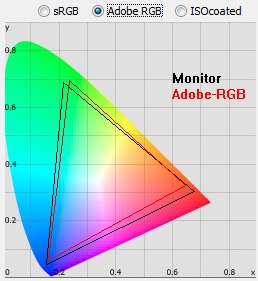
We have also provided a comparison of the
colour space of the screen against the Adobe RGB reference to which it is
reasonably close. It does not quite cover some green shades but does extend past
Adobe RGB in some red shades in this 2D view of the gamut. It should be
noted that this screen does not offer any kind of preset Adobe RGB emulation mode and
so you cannot more closely match the Adobe RGB reference than this. There is an
sRGB emulation mode though which is useful.

The gamma of the screen was reasonably well set up with an
average gamma of 2.3 being recorded, with a deviance of only 4% from the target
of 2.2. The gamma curve was more accurate in lighter grey shades as you can see
from the above table, and strayed a little further from the target in darker
shades up to 2.28. In fact the average gamma was 2.27 here, being rounded up to
2.3 in the LaCie report. White point was recorded at 5744k being 12% out from
the target of 6500k unfortunately. It seems the default 6500k mode is not quite
correct. As we had identified with the naked eye the screen was too bright and
was recorded at a high luminance of 244
cd/m2 which was
only just shy of the specified maximum brightness of 270 cd/m2. Black
depth was measured at 0.35 cd/m2, giving us a static contrast ratio
of 703:1. This was moderate for an IPS panel, but not as high as some other IPS
based
models we have tested which have reached up to around 1000:1.
Default colour accuracy was
mediocre with an average dE of 4.4 but a maximum of 12.4. You will certainly
need to turn down the brightness of this monitor, and some kind of profiling
would be beneficial to correct the slight gamma variations and the colour
accuracy. Of course with a screen of this type you will almost certainly want to
be using a calibration device to really take advantage of the capabilities of
the display anyway.

|
Monitor OSD Option |
Default Settings |
|
Brightness |
100 |
|
Contrast |
100 |
|
Temperature |
Standard |
|
Gamma |
Standard |
|
RGB |
n/a |
|
Mode |
sRGB |
|
Auto EcoView / EcoView Sense |
Off |

Eizo SX2762W - Default Factory Settings, sRGB Mode
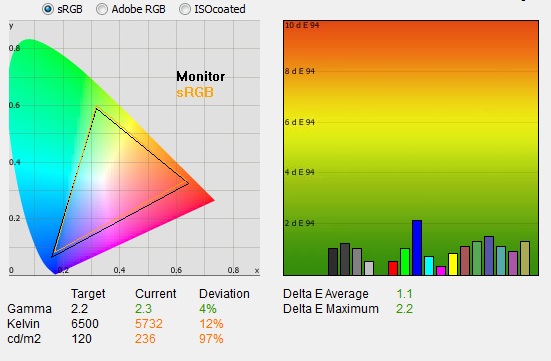
|
|
Default Settings,
sRGB mode |
|
luminance (cd/m2) |
244 |
|
Black Point (cd/m2) |
0.35 |
|
Contrast Ratio |
700:1 |
The screen offers a very useful sRGB preset mode
which is designed to emulate the smaller sRGB colour space. This can be very
useful for those working with standard gamut / sRGB content who do not want to
contend with the oversaturation and colour management issues associated with a
wide gamut screen. If you are working simply with "normal" sRGB content then
viewing that on a wide gamut screen, it can lead to oversaturation of colours,
and certain shades can look unrealistic or too neon. Reds and greens for example
can look very bright and skin tones can look strange. Some users actually like
the bright, vivid colours anyway especially in games and movies, but others who
are looking for accuracy and who don't want to deal with the complications of a mis-match
across their workflow may instead want to use a monitor with a
standard sRGB gamut. In the case of the SX2762W you can have the best of both
worlds through this emulation mode. We switched to this sRGB mode and tested it
at its default settings. You will note that the colour temperature and gamma
settings were now labelled as 'standard' in the OSD menu, and we also lost
access to the RGB controls.

As you can see from the CIE diagram the sRGB
emulation offers a very reliable coverage of the sRGB colour space and works
very well. The monitors gamut almost exactly matches the sRGB reference in this
2D view which is great. Some of the other areas remain unchanged and the gamma,
colour temperature, luminance, black depth and contrast ratio are almost exactly
as they were before. The colour accuracy however is improved drastically and
this mode offers an excellent factory calibration it seems. dE was 1.1 average
with only 2.2 maximum dE. For those wanting to work with the sRGB colour
space only, this is a very welcome and well set up preset mode.

Testing Colour Temperatures
The SX2762W features a wide range of control over
the 'colour temperature' within the OSD menu, with steps of 100k available. We
measured the screen with the X-rite i1 Pro spectrophotometer at several steps to
establish their colour temperature / white point. All other settings were left
at factory defaults and no ICC profile was active. The results are recorded
below:
|
Preset Colour
Temp (k) |
Measured
Colour Temp (k) |
Deviance (k) |
|
4000 |
3590 |
-410 |
|
4500 |
4041 |
-459 |
|
5000 |
4491 |
-509 |
|
6000 |
5376 |
-624 |
|
6500 (default) |
5809 |
-691 |
|
7500 |
6683 |
-817 |
|
8000 |
7108 |
-892 |
|
9000 |
7946 |
-1054 |
|
10000 |
8754 |
-1246 |
|
Native |
6350 |
n/a |
As you can see there is a deviance between the
specified colour temperature and the recorded colour temperature in all of these
modes. At the warmer end the deviance is less and at the warmest 4000k setting
it is only 410k out. As you increase the setting the reality strays further away
from the requested temperature and there is a deviance of 1246k at the coolest
10,000k setting. The 6500k default mode was 691k out from the target sadly, but
the 'native' colour temperature mode seemed to actually be closer to our target,
and was measured at 6350k.

Calibration Results -
Software Profiling
I wanted to calibrate and profile the screen to determine what was possible with optimum settings and
profiling. I used the
X-rite i1 Pro spectrophotometer
combined with the LaCie Blue Eye Pro software package to achieve these results
and reports. An NEC branded and customised X-rite i1 Display 2 was used to
validate the black depth and contrast ratios due to lower end limitations of the
i1 Pro device.
In the first case we carried out a basic software
level profiling of the screen. Changes would be made at the hardware level
through adjustments to the OSD menu brightness. contrast and RGB controls
manually during the process. We
changed to the 'native' colour temperature mode to start with as this had
returned us a default white point closest to our target of 6500k. This screen is
of course designed to be hardware calibration, and we will test that shortly as
well.

Eizo SX2762W - Calibrated Settings, Software Profiling, Wide Gamut
|
Monitor OSD Option |
Calibrated Settings |
|
Brightness |
30 |
|
Contrast |
100 |
|
Preset mode |
User 1 |
|
Colour Temperature |
Native / User |
|
Gamma |
2.2 |
|
RGB Channels |
99, 98, 100 |
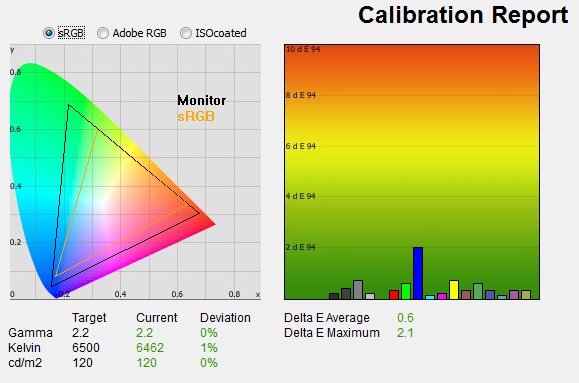
|
|
Calibrated Settings,
Wide Gamut mode |
|
luminance (cd/m2) |
120 |
|
Black Point (cd/m2) |
0.18 |
|
Contrast Ratio |
649:1 |
During the calibration process we adjusted the
brightness and RGB gain in line with the guidance from the LaCie software. In
changing the RGB channels the colour temperature mode reverted to 'user' which
confirms you are using a manually adjusted setup for RGB. After this I let the software
carry out the LUT adjustments at a graphics card level and create an
ICC profile.
In nearly all areas, the software profiling calibration could be considered
a success. Gamma was improved and was now 2.2 on average. White point was within
1% of the target at 6462k, and colour accuracy was improved nicely with dE
average of 0.6, and maximum of 2.1. It seemed to have trouble correcting the
blue shades properly for some reason despite multiple attempts and different
settings. Luminance had been reduced to a more comfortable 120
cd/m2 through
the adjustment of the brightness control to 30%, and the calibrated black depth
was 0.18 cd/m2. This gave us a mediocre calibrated contrast ratio of
649:1. Ok for an IPS panel but not as good as some modern IPS screens. Testing the
screen with a series of colour gradients showed very smooth transitions with no
evidence of banding at all, and only some very slight gradation in darker tones.
You can use our settings and
try our calibrated ICC profile if you wish, which are available in
our ICC profile database. Keep in mind that results will vary from one
screen to another and from one computer / graphics card to another.

Eizo SX2762W - Calibrated Settings, Software Profiling, sRGB Gamut
|
Monitor OSD Option |
Calibrated Settings |
|
Brightness |
35 |
|
Contrast |
100 |
|
Preset mode |
sRGB |
|
Colour Temperature |
Native |
|
Gamma |
Standard |
|
RGB Channels |
n/a |
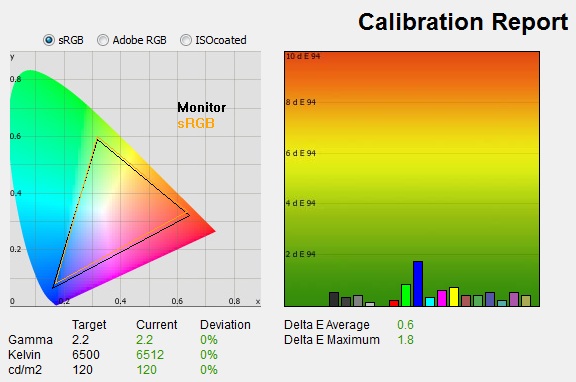
|
|
Calibrated Settings
sRGB mode |
|
luminance (cd/m2) |
120 |
|
Black Point (cd/m2) |
0.20 |
|
Contrast Ratio |
601:1 |
We then switched to the sRGB preset mode to carry
out a software profiling of the screen in the smaller colour space. In this mode
you do not have access to the RGB channels at all and so we left the gamma mode
at its default 'standard' setting and again changed the colour temp mode to
'native' as it was the closest starting point to our 6500k target. We altered
the brightness as guided by the software and then let the calibration device and
software
make the corrections at the graphics card LUT level again.
Again the software calibration was largely a
success with gamma, white point and luminance targets being met nicely. You will
note that the emulation of the smaller sRGB colour space is very reliable which
is great news for those wanting to work with a smaller colour space than is
natively supported by the backlight unit. Contrast ratio after calibration was a
little lower here at 601:1 and there still seemed to be an issued correcting the
blue shades completely, leaving us with a dE average of 0.6 and maximum of 1.8.
Gradients were again very smooth with no evident banding and only some slight
gradation in darker tones.
You can use our settings and
try our calibrated ICC profile if you wish, which are available in
our ICC profile database. Keep in mind that results will vary from one
screen to another and from one computer / graphics card to another.

Eizo EasyPIX
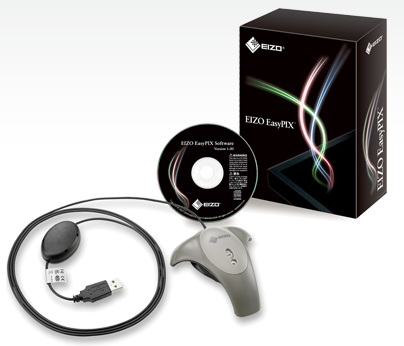
To allow users to get the most out of their
screens like this, Eizo provide their own 'EasyPIX' calibration package which is
an optional extra with this FlexScan SX2762W screen. The package consists of an
EasyPIX software CD along with an Eizo branded DataColor Spyder3 device which
they refer to as the "EX1 Photo Sensor". It allows you to hardware calibrate and
tweak your screen and can also be used for colour matching between your prints
and monitor. We downloaded the latest version of the software to test it. For
Windows this is a pretty big 57.7Mb file (v2.1.2) and for Mac OS it is a
whopping 106Mb. Unfortunately though we did not have access to the EX1 Sensor in
the package and so the tests are limited here.
We have
used and tested various Spyder3 tools in the past and to be honest have found
the results very varied and not particularly reliable. I expect as part of this
EasyPIX package the units have been custom tweaked and set up for use with Eizo
displays, and so would hopefully offer a high level of performance as a result.
The monitor must be connected via the USB cable to your PC in order for it to
communicate. We will have a quick look at the software package here:
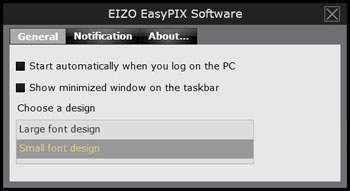
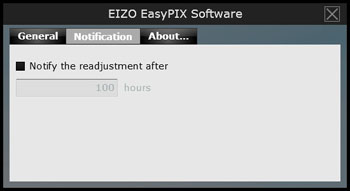
When launching the software it loads as a utility
in your system tray. You can access the settings from here and when you launch
the main window for the program. There are some options to enable/disable
auto-start and set reminders to adjust the screen at an interval to suit.
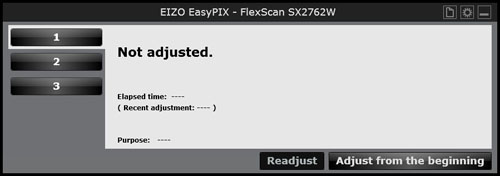
Loading the main software window presents you with
a basic adjustment screen as shown above, giving you 3 possible calibration
profiles along the left hand side. If this is the first time you've adjusted the
screen you have to click "adjust from the beginning" to progress. It should be
noted that because we didn't have access to the EX1 Sensor device, clicking
"adjust from the beginning" did not allow us to carry out a calibration of the
screen ourselves. We tried the software with various devices including an i1
Display 2, i1 Pro and even a normal Spyder3 device. None communicated with the
software to allow for a screen calibration, and on checking with Eizo they
confirmed that the software is locked to their EX1 Sensor. This is a bit of a
shame as it forces you to buy their device if you want their free software
solution to calibrating the screen at a hardware level. If you don't have the
EX1 Sensor then you will need to find another software package which allows you
to calibrate the screen at a hardware level. We will look at this in a moment,
but needless to say they would be an additional cost. It would have been nice if
Eizo had allowed compatibility of their EasyPIX software with third party
devices for those who already own a colorimeter and just want to hardware
calibrate their new screen using it.
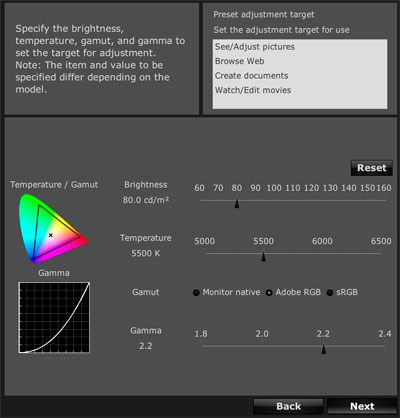
For a quick overview we have provided some
screenshots of what would be available from the software if you did use an EX1
Sensor and could carry out the calibration as normal. Once you have entered the
process, you can
define your targets for luminance, colour temperature, the gamut of the screen
and the gamma. Once defined you can start the process and it will automatically
adjust these for you at the monitors hardware LUT level. It is interesting to
see here that as a gamut mode you are able to define in their software a
calibration to the Adobe RGB colour space, which is otherwise not available from
the OSD preset modes. This might be useful for those wanting to reduce the
native gamut a little to this Adobe RGB space. These are the only settings you
can define and you can then progress into the calibration process.
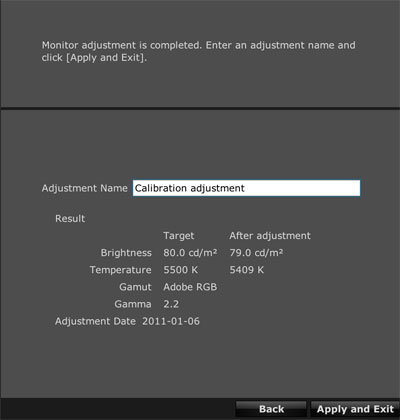
At the end you are presented with a summary screen
of your results but it has very small amounts of data as you can see. There's no
more complex validation report available sadly like you might see from other
packages such as those from LaCie and BasICColor.

Once completed, if necessary,
you can fine-tune the brightness and colour manually by selecting "Finely
Adjust." We would have liked to have been able to test this software in
full but as we've said it is unfortunately locked to the EX1 sensor. As such you
can't use this software to hardware calibrate the screen with other devices and
so we will find an alternative to get the most out of the screen through
adjustments to the monitors LUT. The software itself seems easy enough to use
although is quite basic and lacks any real reporting or validation function.
For more information about
EasyPIX please see
Eizo's website.

Hardware
Calibration (BasICColor Display)
As we have already discussed, the SX2762W is
capable of being hardware calibrated. The screen allows you to control and
adjust the internal 16-bit LUT of the screen for optimum performance, accuracy
and control. Eizo will only allow you to use their EasyPIX software with the
screen if you also purchase and use their re-branded Spyder3 sensor (EX1 Photo
Sensor) and so if you want to use another device you will need to find an
alternative software package which is capable of making hardware level
adjustments.
We tried various popular and high end packages to
see which would allow communication with the hardware LUT and a full
calibration. We had no luck with the LaCie Blue Eye Pro software which only
allowed us to make software level calibrations as we have already
carried out earlier.
Quato's iColor Display (v3.8.3) also did not allow hardware calibration with
this screen and seems to only support hardware control for their own range of
screens. However, we did find that BasICColor Display (the latest v5.0.3) did
allow hardware calibration which was great news. BasICColor even offer a free
14-day trial license which allows you to test the software in full if you need
to. It's a very decent package and has a great range of options, along with a
very good reporting and validation function.
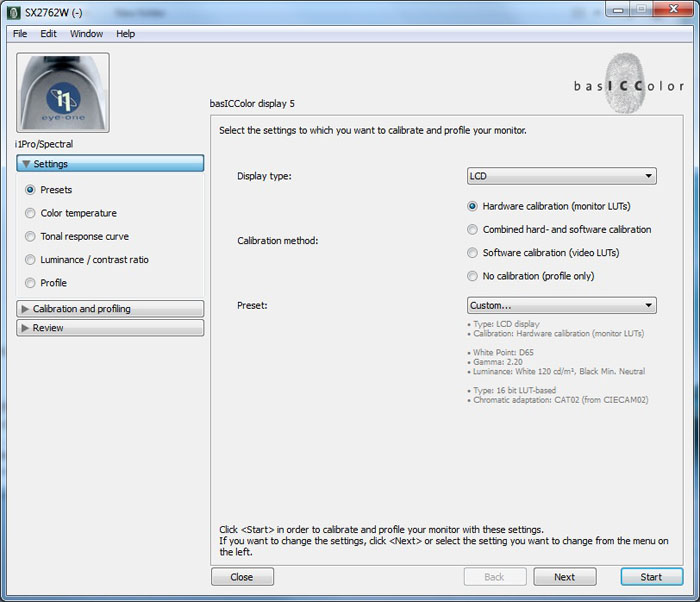
Loading up the software presents you with the
screen above, where you can see hardware calibration is available as an option.
On a screen without hardware calibration support this would be greyed out
normally. You can select your device and then control various aspects of your
target settings from the left hand side. You can instead select from a series of
preset settings if you would rather from the drop down on the right. We have
opted to define our own custom settings in line with our normal review targets.
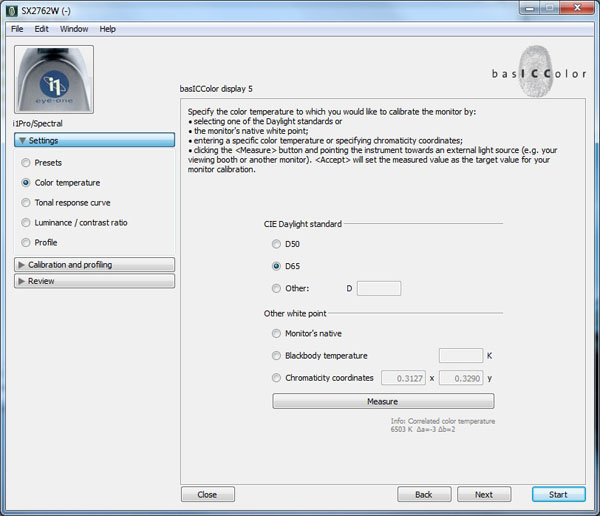
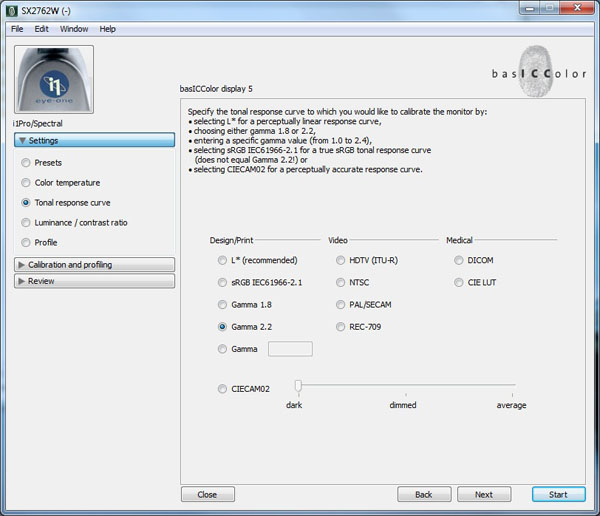
We will give you a quick overview of some of the
settings and sections. Above you can control the white point / colour
temperature target and then the gamma curve.
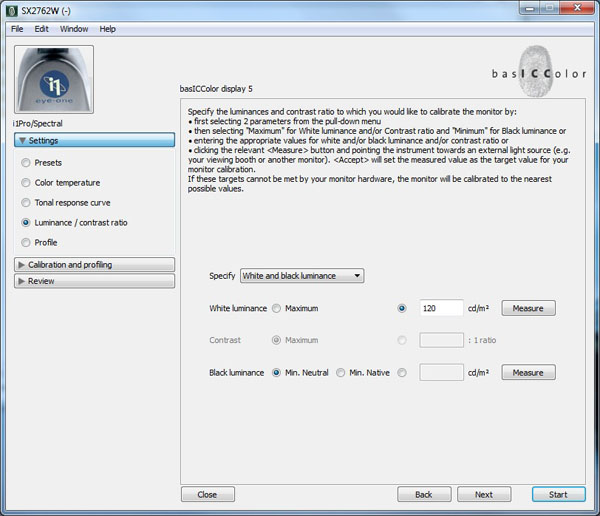
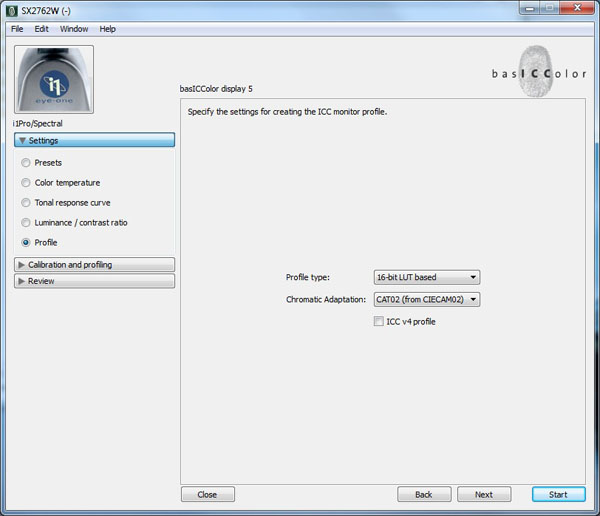
You can also define the target luminance and black
point and set the type of profile which will be created. There's also a handy
option to measure the current luminance and black point (and therefore contrast
ratio) if you need. Once targets have been defined you press start, align your
device on the screen (here we used our i1 Pro Spectrophotometer) and then the
process is entirely automated. The software is able to control the monitor at a
hardware level and so you need make no adjustments to the brightness, contrast
or RGB levels in the OSD menu. You can carry out this hardware calibration when
in any of the 3 user modes from the OSD menu and it will make changes to all the
OSD controls for you automatically. That preset then becomes your customised
hardware calibrated mode which you can switch to and from whenever you like. So
you do have the option to set up 3 different presets with different settings for
different uses.

Eizo SX2762W - Calibrated Settings, Hardware Calibration, Native Gamut
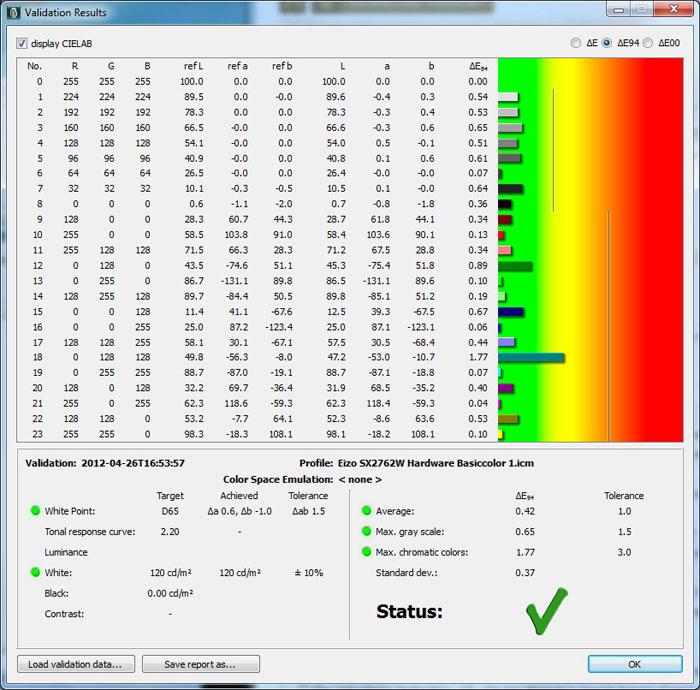
|
|
Calibrated Settings,
Hardware Calibration |
|
luminance (cd/m2) |
120 |
|
Black Point (cd/m2) |
0.18 |
|
Contrast Ratio |
667:1 |
The process itself takes a good 5 minutes to
complete and at the end you are presented with a validation report as shown
above. This measured various aspects of the screen after the calibration in a
decent amount of detail. You may note here that I have removed the measured
black point and resulting contrast ratio from the results. That is because the
measurements were made using the i1 Pro which has poor low light accuracy (<0.20
cd/m2). Instead we validated the black depth and contrast ratio
separately as shown in the small table beneath using an NEC optimised i1 Display
2 colorimeter.
From the hardware calibration you can tell the
results were very pleasing. White point had been met very closely within a very
small deviance. With a luminance of 120 cd/m2 we had a calibrated
black depth of 0.18 cd/m2 and a static contrast ratio of 667:1 which
was actually slightly higher than when we had carried out software profiling of
the screen. Colour accuracy was also great with a dE average of 0.42.
Testing the screen with a
series of colour gradients showed very smooth transitions with no evidence of
banding at all, and only some very slight gradation in darker tones.
Since this hardware calibration we will refer to
these results as our optimum achieved performance for the comparisons and in the
rest of the review.
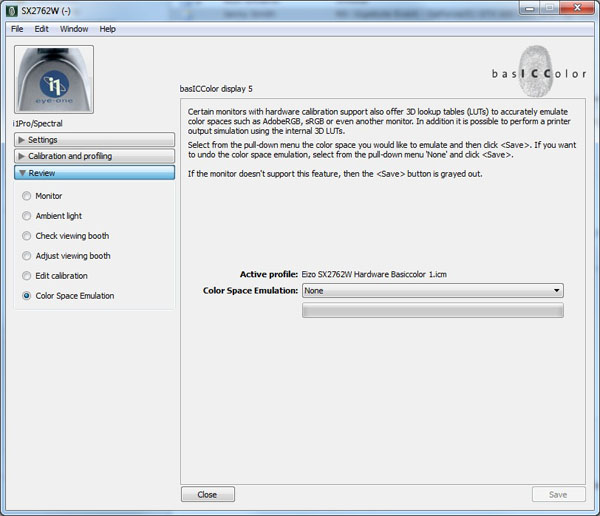
As a side note, the BasICColor software offers an
option for colour space emulation, allowing you in theory to emulate the
slightly smaller Adobe RGB colour space, or even the sRGB colour space. On the
SX2762W this option was not available and so it seems the BasICColor software
cannot be used to control this colour space emulation on this screen. As a
result, you have a slightly limited control over the calibration of the screen.
By default, the screen offers a series of OSD presets which all operate in the
native full wide gamut. There is an sRGB mode which can offer reliable emulation
of the smaller sRGB colour space. Thankfully this is also well factory
calibrated in many areas. There is no OSD mode for Adobe RGB emulation available
however, leaving a gap for those who might want to closely match this colour
space.
From a calibration point of view you can software
calibrate the screen in either the full native gamut or in the sRGB mode. From a
hardware calibration point of view the flexibility is a little less. Eizo's
EasyPIX software seems to offer colour space emulation for hardware calibration
including modes for Adobe RGB and sRGB. Since this software only works with
their EX1 Sensor, this is not readily available when using other devices and we were unable to test it to
confirm if it worked correctly. As an alternative for hardware calibration we
found that the BasICColor software worked well, while other packages did not
support hardware level calibration. However, it does not allow you
to choose colour space emulation on this screen and so you can only hardware
calibrate the screen at full native gamut or in the sRGB mode. It would have
been nice to see support for third party devices with the EasyPIX software or
support for colour space emulation using BasICColor really. As a result you have
very little flexibility if you want to work in the Adobe RGB colour space
exactly (as opposed to the wider native gamut) and it seems the only option if
you do would be to purchase the Eizo EX1 Sensor package. A shame if you already
have another device you've spent money on.

Eizo SX2762W - Calibrated Settings, Hardware Calibration, sRGB Gamut
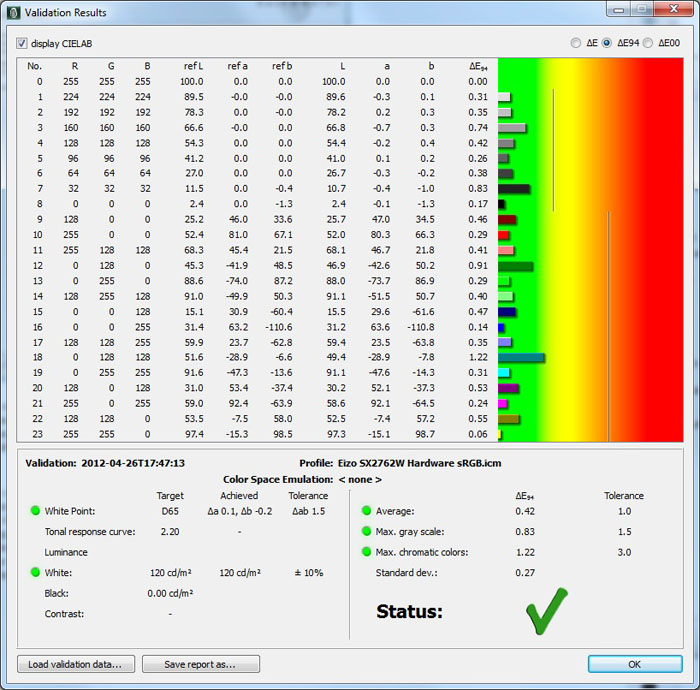
|
|
Calibrated Settings,
Hardware Calibration, sRGB mode |
|
luminance (cd/m2) |
120 |
|
Black Point (cd/m2) |
0.19 |
|
Contrast Ratio |
626:1 |
For reference I also carried out a hardware
calibration of the SX2762W using the BasICColor Display software when in the
sRGB preset mode. This mode allowed emulation of the smaller sRGB colour space
and the software allowed further corrections to be made in all other areas, As
you can see, calibration was again a great success, although the calibrated
static contrast ratio was a little lower here at 626:1.

Calibration
Performance Comparisons

I've provided a comparison above of the SX2762W
against some of the other screens we have tested. Out of the box average dE was
4.4 which was not particularly good compared with some other screens. Perhaps
the most direct competitor here for the Eizo is the
NEC
PA271W and
SpectraView Reference 271 models which were more accurate out of the box in
terms of colour accuracy (1.1 and 1.5 dE average respectively). The NEC uses the
same LG.Display IPS panel and offers hardware calibration support and a whole
host of high end pro-grade features. The default factory set up, at least in the
default preset mode was much better on the NEC models. The Dell U2711 is also
another popular 27" IPS alternative for a more mainstream user. Out of the box
colour accuracy was a little better than the Eizo as well at 3.7 dE average.
Some form of software profiling using a colorimeter, or preferably hardware
level calibration would be useful to correct the colours and also any other
discrepancies in the gamma and white point. Given this is a professional grade
screen which costs a lot of money it is important to have access to a
calibration tool to really get the most out of it. I expect users considering a
screen like this would have a device available or at least plan to buy one at
the same time.

Once calibrated the dE average was reduced to 0.4.
This would be classified as excellent colour fidelity by LaCie. It was not quite
as low as some of the other screens here which reached down to 0.2 average, but
in practice you would not notice any real difference here. Professional grade
monitors like this Eizo and also the NEC PA series and P241W offer other high
end features which separate them from some of the other models shown above as
well, including extended internal
processing and hardware calibration. These comparisons are based on a
small selection of tests, so it should be remembered that other factors do come
into play when you start talking about professional use. As such the NEC and
Eizo screens here should really be separated from the others when talking about
absolute accuracy and reliability.


The calibrated contrast ratio of
the SX2762W was ok, but not great by modern IPS standards. The contrast ratio
was 667:1 after calibration which was comparable to some other screens including
the Dell U2711 (672:1) and NEC PA271W (600:1). Some other smaller IPS
panels are capable of higher contrast ratios though, such as the Dell U2412M
(947:1) and HP ZR2440w (935:1). Other technologies such as PVA and MVA can offer
very impressive contrast ratios, ranging up to 1977:1 in this comparison for
example on the BenQ EW2730V (AMVA based). On some other screens the static
contrast ratio of modern MVA and PVA panels can reach even higher, up to ~3000:1
which IPS cannot compete with at the moment.

Contrast
Stability
I wanted to see how much variance there was in the screens contrast as we
adjusted the monitor setting for brightness.
In theory, brightness and contrast are two independent parameters, and good
contrast is a requirement regardless of the brightness adjustment.
Unfortunately, such is not always the case in practice. We recorded the
screens luminance and black depth at various brightness settings, and
calculated the contrast ratio from there. Graphics card settings were left at
default with no ICC profile or calibration active. Tests were made using an
NEC branded and customised
X-rite i1 Display 2 colorimeter. It should be noted that we used the
BasICColor calibration software here to record these, and so luminance at
default settings may vary a little from the LaCie Blue Eye Pro report.
|
OSD Brightness |
Luminance
(cd/m2) |
Black Point (cd/m2) |
Contrast Ratio
( x:1) |
|
100 |
238.2 |
0.34 |
703 |
|
90 |
237.2 |
0.34 |
698 |
|
80 |
225.1 |
0.32 |
703 |
|
70 |
203.6 |
0.29 |
702 |
|
60 |
185.0 |
0.27 |
685 |
|
50 |
163.6 |
0.24 |
682 |
|
40 |
144.0 |
0.21 |
686 |
|
30 |
123.4 |
0.18 |
686 |
|
20 |
101.1 |
0.15 |
674 |
|
10 |
82.3 |
0.12 |
686 |
|
0 |
62.4 |
0.10 |
624 |
|
Luminance Adjustment Range = 175.8 cd/m2
Black
Point Adjustment Range = 0.24
cd/m2
Average
Contrast Ratio = 684:1
|
The luminance range of the screen was very good
with a total adjustment range of the backlight of 175.8 cd/m2. At the
top end, the maximum brightness setting returned a luminance of 238 cd/m2
which was a little shy of the 270 cd/m2 specified maximum brightness.
At the lowest setting the screen reached a nice low 62 cd/m2 and so
even those wanting to use the screen in low light conditions should be fine. A
setting of around 25 - 30% should return you a luminance of around 120 cd/m2
if needed. Black depth ranged from 0.34 down to 0.10 cd/m2 and
reduced as you lowered the brightness setting as you would hope.

The plot of the luminance on the above graph shows
that the adjustment of the backlight is not quite linear overall. At the top end
of the range the settings between 100 and 90 didn't seem to alter the backlight
at all, but after that the change reduced the overall luminance as it should in
a linear fashion.
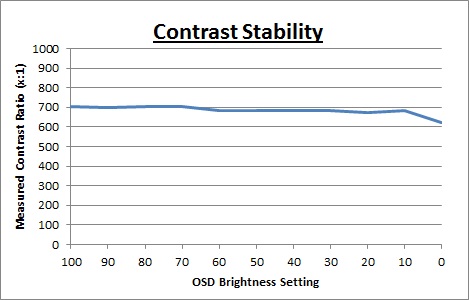
The contrast ratio remained very stable across the
range of brightness adjustments which was pleasing, except at the very lowest
settings where it was reduced a little between 10 and 0% brightness. The average contrast
ratio was 684:1 at default settings which is reasonable, but not great for a
modern IPS panel.

Dynamic Contrast

The Eizo SX2762W doesn't feature a dynamic
contrast ratio as such but it does offer a "Contrast Enhancer" option from
within the advanced settings section of the Color menu as shown above.
According to the manual "This feature manages the brightness and gain
levels of the backlight to match the image displayed while also improving the
sense of contrast of images by correcting gamma values." In practice it
didn't seem to do much at all, although when switching between extremes of a
100% black image and then returning to a normal desktop, you could see it take
around a second to stabilise the gamma and colour tones a little and return
them to normal. It doesn't seem to control the backlight intensity at all and
so has no impact on a dynamic contrast ratio, but seems to make some more
finite adjustments at the digital white and black levels perhaps and through
changes to the gamma.

Viewing Angles

Above: Viewing
angles shown from front and side, and from above and below. Click for
larger image
Viewing angles of the SX2762W were very good as
you would expect from an IPS based panel. Horizontally there was very little
colour or contrast shift at all until wide angles past about 45°. Contrast shifts were
slightly more noticeable in the vertical field but overall they were very good.
The screen did offer the wide viewing angles of IPS technology and was free from
the very restrictive fields of view of TN Film panels, especially in the
vertical plane. It was also free of the off-centre contrast shift you see from
VA panels.
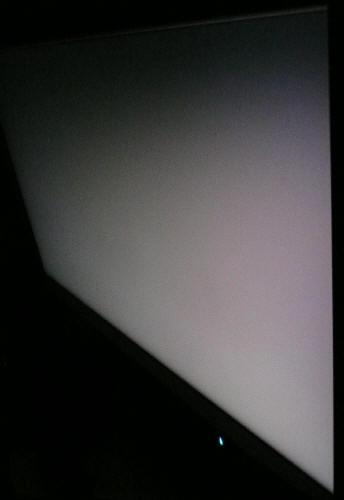
Above: View of an
all black screen from the side. Click for larger version
On a black image there is a characteristics IPS
white glow, but in normal working conditions this shouldn't present too much
of a problem. The above image was taken in a darkened room to demonstrate the white
wide angle glow when viewing a black screen. There is no A-TW polarizer on this
panel which is rarely used now in the market but was implemented on some older
screens to improve the off centre black viewing. If you are viewing dark content
from a close position to the screen you can sometimes see this pale glow on
parts of the screen towards the sides and corners because of your proximity to
the screen and your line of sight. This is accentuated a little due to the size of the
27" panel. The edges of the screen are at an angle from your line of
sight which means you pick up this white glow to a smaller degree if working
with dark content. This
disappears as you move backwards away from the screen where the line of sight
does not result in a wide angle view of parts of the screen and you can see the
screen largely from head on. It is only really apparent on darker content and
only really if you are working in darkened lighting conditions on this model.

Panel Uniformity
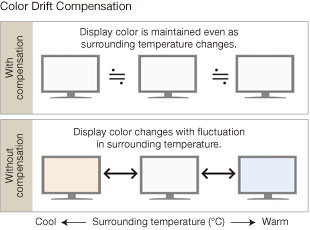
The Eizo SX2762W offers an advanced feature
which is designed to help improve uniformity and stabilize the image being
displayed. This is much like NEC's ColorComp but here Eizo refer to it as
DUE, or Digital Uniformity Equalizer. Fluctuations in brightness and chroma
on different parts of the screen are characteristic of LCD panels and
particularly apparent on larger displays. DUE is designed to help compensate
for these errors, resulting in a much more uniform image. In addition
to that, to ensure proper display of colour, the FlexScan SX2762W comes
equipped with patented Eizo technology that stabilizes the monitor's brightness level
after start-up or coming out of power saving mode. Furthermore, a temperature
sensor detects and automatically suppresses changes in colour and brightness
caused by fluctuations in the surrounding temperature. Both these features
including the DUE are enabled by default and cannot be turned off or down at
all. As such, the features are always enabled on the SX2762W.
Measurements of the screens luminance were taken
at 35 points across the panel on a pure white background. The measurements
were taken using BasICColor's calibration software package, combined with
the NEC customised X-rite i1 Display 2 colorimeter. The above uniformity
diagram shows the difference, as a percentage, between the luminance
recorded at each point on the screen, as compared with the reference point
in the centre of the screen of 120
cd/m2. The below
shows the variance in the luminance across the screen compared with this
point as a percentage. It is worth noting that panel uniformity can vary
from one screen to another, and can depend on manufacturing lines, screen
transport and other local factors. This is only a guide of the uniformity of
the sample screen we have for review.
Uniformity of Luminance

The luminance uniformity of the Eizo SX2762W
was excellent as you can see from the above. The luminance deviated by only
-4.35% at the lowest level (down to 115
cd/m2 in the
bottom left hand corner) and up by only +2.44% in portions of the left hand
half (up to 123 cd/m2 maximum). The DUE technology is obviously
doing a wonderful job of controlling and stabilising the luminance of the
panel and as a result you have a very uniform brightness indeed. The only
possible disadvantage to DUE and other uniformity correction technologies is
that they can sometimes have an impact on contrast ratio. Given the fairly
mediocre contrast ratio we recorded for this screen (~677:1 once calibrated)
it might have been nice if the user was able to control the level and
intensity of the DUE like on NEC's ColorComp control. This might have helped
return a higher contrast ratio we expect which some might prefer. Nevertheless, for the
purposes of this particular test it performed excellently.
Backlight Leakage
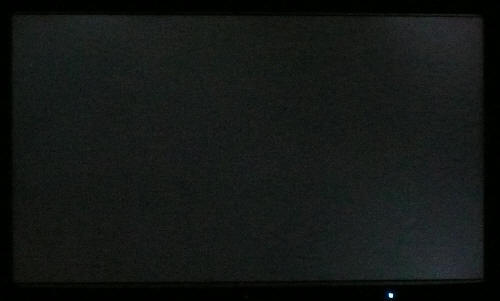
Above: All black screen in a darkened room. Click for larger version
As usual we also tested the screen with an all
black image and in a darkened room. A camera was used to capture the result. The
overall appearance of the screen in this test was good really, with only some
slight pale clouding towards the top and bottom right hand corners of the screen,
which you can pick out in the photo. There was no severe backlight bleed along
any of the edges thankfully.

General and Office Applications
The Eizo SX2762W features a massive 2560 x 1440
WQHD resolution which is only just a little bit less vertically than a 30"
screen. The pixel pitch of 0.233mm is very small as a result, and by comparison
a standard 16:10 format 24" model has a pixel pitch of 0.270mm and a 30" model
has 0.250mm. These ultra-high resolution 27" models offer the tightest pixel
pitch and therefore the smallest text as well. I found it quite a change coming
from 21.5 - 24" sized screens, even those offering quite high resolutions and
small pixel pitches. Some users may find the small text a little too small to
read comfortably, and I'd advise caution if you are coming from a 19" or 22"
screen for instance where the pixel pitch and text are much larger. I found a
30" screen to be quite a change with text size when I first used one, and this
is very similar and even a little bit smaller! I still personally prefer the
slightly larger text of a 24" model myself, but I expect I could happily get
used to the added resolution on these models given time. The extra screen size
also takes some getting used to over a few days as there really is a lot of room
to work with.
The massive resolution is really good for office
and general use, giving you a really big screen area to work with and it's
excellent for split screen side by side working. It is a noticeable upgrade from
a 24" 1920 x 1200 resolution, and it's good to see Eizo have opted for a high
res panel here rather than reverting to a 1920 x 1200 / 1920 x 1080 res panel as
you may find in other older 27" models. For those wanting a high resolution for
CAD, design, photo work etc, this is a really good option. The image was very
sharp and crisp and text was very clear over the digital DVI and DisplayPort
interfaces. There is no analogue input offered here to compare with because of
the high native resolution of the panel.
There were a couple of preset modes you may want
to try and use for office work. The 'paper' mode is very bright with a 100%
brightness setting by default. The colour temperature in the OSD menu is also
set at 4500k which makes the image look very yellow. Then there is the 'text'
preset mode. This is set at 10% brightness and with a 5000k colour temperature.
As a result it's quite a bit darker than our calibrated user mode (at 120
cd/m2) and a
little warmer. These might be useful for some people, although I didn't feel
they were ideal preset modes. The paper mode is too yellow in colour and the
text mode is very dark.
The screen offers a 2 port USB hub which is useful
for connecting external devices. The ports are located on the back of the screen
so they aren't the easiest to reach for quick connecting and disconnecting of
devices. Fine for leaving things connected and tucked nicely out of the way, but
I would have liked to have seen a couple of ports on the side of the bezel for
easier access. There was a very good range of ergonomic adjustments available
from the screen and all were pretty smooth to operate. The height adjustment was
perhaps a little cumbersome given the size and weight of the screen itself. The
screen even offers a rotation function, although this is probably impractical at
this size. Some of the energy saving features are also great to see included,
and should be useful in an office environment as well where multiple screens are
set up. The ambient light sensor can be handy for altering the backlight
intensity with changing lighting conditions, and the human motion sensor is a
nice extra feature. The only other thing left off which I would have perhaps
liked to have seen, but which is rarely offered, is a card reader of some sort.

Above: photo of
text at 2560 x 1440 (top) and 1920 x 1080 (bottom)
The screen is designed to run at its native
resolution of 2560 x 1440 and at a 60Hz recommended refresh rate. However, if
you want you are able to run the screen outside of this resolution. We tested
the screen at a lower 1920 x 1080 resolution while maintaining the same aspect
ratio (16:9) to see how the screen handles the interpolation of the resolution.
At native resolution the text was very sharp as you can see from the top
photograph. When you switch to a lower resolution the text is a little more
blurry although to be honest the image still looked pretty good to the naked
eye. There was some slight overlap of the text across pixels leading to the
slight blur, but it was not as bad as we'd seen on some other screens. Of course
native resolution is recommended wherever possible.

Responsiveness and Gaming
The SX2762W is rated by Eizo as having a 6ms G2G
response time which implies the use of
overdrive / response time compensation (RTC) technology, used to boost pixel
transitions across grey to grey changes. The
LG.Display LM270WQ2-SLA1 IPS panel being used is rated by LG.Display with a
12ms ISO response time (black > white > black) as well to give you the full
information.
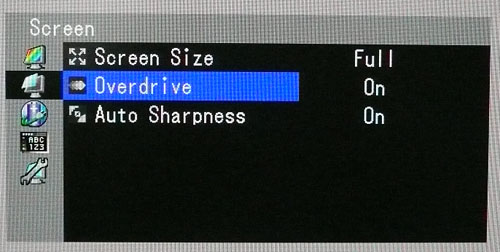
Before we get in to the side by side screen
comparisons I want to quickly talk about the
'overdrive' control available through the screens OSD menu. It is available
within the 'screen' section as shown above. This allows you to manually control
the activation of overdrive / RTC impulse on the screen, with settings of on and
off available. Overdrive is designed to help improve pixel responsiveness and
reduce motion blur and ghosting in practice by speeding up the transitions the
pixels make to change from one colour to another. You may wish to read our
specs section for some further information about overdrive / response time
compensation.
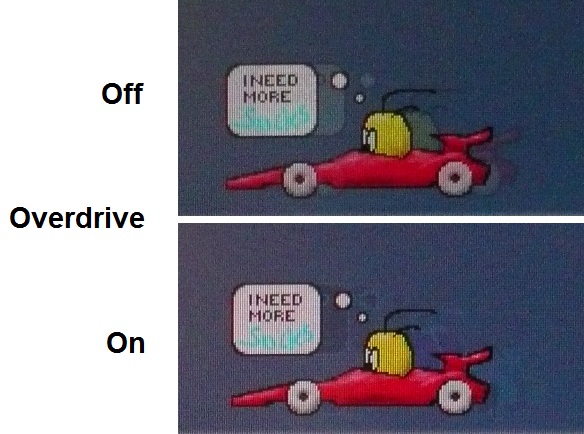
The screen was tested using the chase test in
PixPerAn, a good bit of software for trying to quantify differences in real
terms responsiveness between monitors. As a reminder, a series of pictures are
taken on the highest shutter speed and compared. The images above are the best
case examples from the screen with the 'overdrive' setting turned on and off.
When the overdrive control is set to off there is a more pronounced blur to the
moving image. There are no severe trail images and no obvious ghosting but the
moving image is not as sharp. When you switch overdrive on you can spot an
improvement to the movement of the car, with a reduction in blurring being
noticeable even to the naked eye. However, as a result of the overdrive control
being applied aggressively, and due to the poor control of how it is applied,
there are some artefacts and side effects produced. You can see a dark trail
behind the moving image now which is unfortunate and although it is not too
severe you can notice it in practice. There is a slight pale halo as well
noticeable across some colour transitions. The overdrive control does offer some
improvements in terms of pixel responsiveness in practice and for gaming I
expect most people would prefer to enable this feature. If the dark trails
become too distracting you may wish to switch overdrive off.
Display Comparisons
The screen was tested again using the chase test
in PixPerAn for the display comparisons. As a reminder, a series of pictures are
taken on the highest shutter speed and compared, with the best case example
shown on the left, and worst case example on the right. This should only be used
as a rough guide to comparative responsiveness but is handy for a direct
comparison of the impact of this setting:

27" 6ms G2G
LG.Display H-IPS (Overdrive = On)

27"
7ms G2G LG.Display p-IPS
(response
improve = on)

27"
6ms G2G LG.Display H-IPS

27" 5ms G2G
Samsung PLS (response time = faster)

27" 12ms G2G
LG.Display H-IPS
The SX2762W was not the fastest screen in these
comparisons but did perform quite well nonetheless. Remember that this screen is
not aimed at gamers at all as it is a professional grade monitor and is
expensive as a result. Some users may well want to run the occasional game as
well so while it's useful to test its performance in this area, it needs to be
taken in context. With the overdrive feature enabled the SX2762W performed quite
similarly to the
NEC PA271W / SpectraView Reference 271 screen which is its closest rival of
the screens shown here. There was also some slight dark trailing on the PA271W
when the 'response improve' feature (same as overdrive on the Eizo) was enabled.
The
Dell U2711 is another obvious contender with a similar panel being used and
some similar features on offer. The Dell is however lacking some of the professional
grade features of the Eizo and NEC displays here though and so is a more
mainstream, and lower cost alternative. The Dell again showed some low levels of
motion blur thanks to the use of overdrive on that model. However, the dark
overshoot was more noticeable on the U2711 to the point of being quite
distracting in practice. The
Samsung S27A850D uses a PLS panel from Samsung which is designed to rival
LG.Display's popular IPS technology. That model was very impressive in these
tests, showing very low levels of blur and no obvious overshoot in the 'faster'
response time setting. More aggressive settings of that response time control
did result in overshoot however. Lastly the
HP ZR2740W is again another IPS panel, but this time one paired with W-LED
backlighting. It is rated with a 12ms G2G response time and although it
performed pretty well it was a little behind the others shown here in terms of
motion blur.

27" 6ms G2G
LG.Display H-IPS (Overdrive = On)

27"
6ms G2G LG.Display H-IPS

27"
6ms G2G LG.Display H-IPS

27" 8ms G2G AU
Optronics AMVA (AMA setting = Premium)
I have provided a comparison of the SX2762W against some other models which are
also 27" in size. The responsiveness of the IPS based
Hazro HZ27WC was overall slightly ahead of the SX2762W with an ever so
slightly more
pronounced blur to the moving image, but freedom from the dark overshoot and
trails. The
Hazro HZ27WB was a bit slower than the HZ27WC and the SX2762W with a more
noticeable motion blur, despite its low 6ms G2G spec on paper. The AMVA based 27"
BenQ EW2730V is also included this for comparison to demonstrate that
unfortunately the responsiveness of some modern AMVA panels is somewhat behind
current IPS panels. There is a much more obvious blur and ghost image on that
model, even though its rated with an 8ms G2G response time. This goes to show
you can't always rely on specs to give you a true idea of how a panel will
perform in real life.

27" 6ms G2G
LG.Display H-IPS (Overdrive = On)

24" 6ms G2G
LG.Display e-IPS (Video OverDrive = On)

24" 8ms G2G
LG.Display e-IPS

23" 8ms G2G
LG.Display e-IPS (W-LED)
Above is a comparison of the SX2762W against some popular models in smaller
sizes. Again these other 3 models are IPS based. The
HP ZR2440w had performed very well in these tests and showed a slightly lower
level of motion blur to the SX2762W in practice. There was a very slight dark and
pale halo trail evident in those tests but it was very slight and not quite as
noticeable as on the Eizo. The
Dell U2412M and
U2312HM again offered low levels of motion blur but a more obvious dark
overshoot trail was introduced again. The SX2762W seems to be quite comparable
to the Dell U2412M and U2312HM in practice in these tests which is pleasing
considering it is not a gamer-orientated screen.

27" 6ms G2G
LG.Display H-IPS (Overdrive = On)

27" 1ms G2G CMO
TN Film (Response time mode = Advanced)

24" 2ms G2G AU
Optronics TN Film (AMA = On + 120Hz)

22" 3ms G2G Samsung TN Film + 120Hz
I've also included a comparison above against 3
gamer-orientated screens, including the 27" TN Film based
ViewSonic VX2739wm.
While it is the same size as the SX2762W, it is very different of
course. That model is
aimed primarily at gamers and even has a 1ms G2G quoted response time. It also uses a TN Film panel and offers a much smaller resolution of 1920 x 1080. It
performs a better than the SX2762W in these tests and some of the remaining
motion blur is eliminated, as is the dark overshoot. This is as expected
considering it is a gamer-orientated TN Film model.
The other two models here both featuring heavily
overdriven TN Film panels, and are combined with 120Hz technology. The pixel
responsiveness of both of these is ahead of the SX2762W as well, but more
importantly the 120Hz frequency
allows for improved 120fps frame rates and the support of
3D
stereoscopic content as well.
The recently tested
BenQ XL2420T
offers some very fast performance and is a screen purely aimed at gamers. The
Samsung 2233RZ arguably remains our champion purely on the responsiveness
tests. Both these screens perform faster in practice though thanks to their
120Hz support, giving you smoother moving images and higher frame rates.
The responsiveness of the SX2762W was actually very good really considering this
is a large IPS panel and was not really aimed at gaming at all. When the
overdrive control was turned on, the screen showed low levels of motion blur and
was free from any obvious ghosting. There was a slight dark overshoot introduced
unfortunately due to the poor control of the RTC impulse. It was comparable to
the performance of some popular IPS models like the Dell U2412M for instance
which is actually a pretty decent result. Keep in mind that you will need a
pretty powerful graphics card to cope with the demands of such a high 2560 x
1600 resolution as well.
Additional Gaming Features
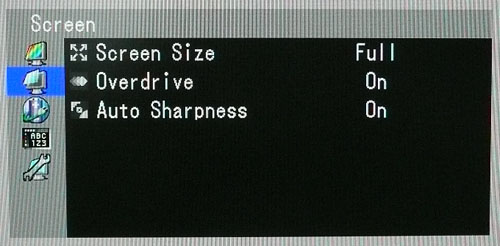
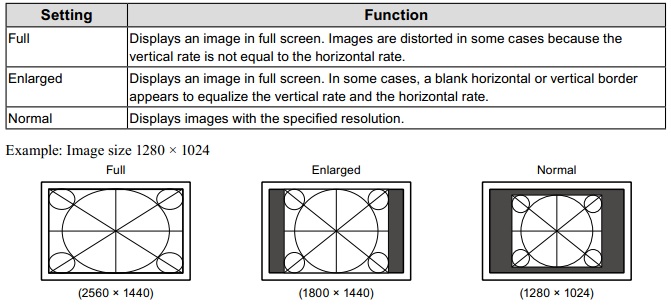
Aspect Ratio Control - The screen offers
three settings for aspect ratio control as shown and described above. The
'normal' setting even offers a 1:1 pixel mapping which is pleasing. There are
then options to fill the screen and stretch the image if necessary, or to
maintain the aspect ratio and enlarge it as much as possible.
Preset Modes - While there are a selection
of 8 preset modes available from this screen, none are specifically aimed at
gaming. You will probably want to set up one of the three 'user' modes to your
taste, perhaps boosting the brightness and colour saturation beyond your normal
every day set-up.

Input Lag
We have recently written an in depth article about
input
lag and the various measurement techniques which are used to evaluate this
aspect of a display. We have also improved our method by adopting the SMTT 2.0
tool which is used to generate the results below. Please see our full
input
lag testing article for all the details.
Input Lag Classification
To help in this section we will also introduce a broader classification system
for these results to help categorise each screen as one of the following levels:
-
Class 1)
Less than 16ms / 1 frame lag - should be fine for gamers, even at high levels
-
Class
2)
A lag of 16 -
32ms / One to two frames - moderate lag but should be fine for many gamers.
Caution advised for serious gaming and FPS
-
Class
3)
A lag of more
than 32ms / more than 2 frames - Some noticeable lag in daily usage, not
suitable for high end gaming
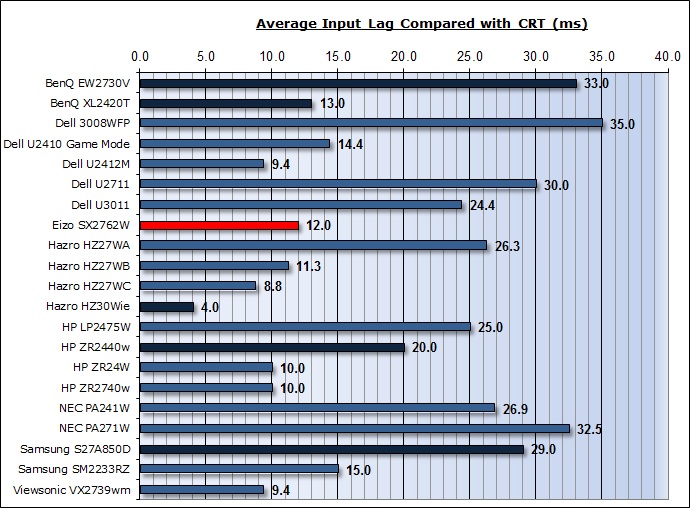
For the full reviews of the models compared here and the dates they were written
(and when screens were approximately released to the market), please see our
full
reviews index.
Our tests here are based on the new format using
SMTT 2.0. We have provided a comparison above against other models we have
tested to give an indication between screens. However, please note that many of the
other screens tested here were using older stopwatch methods and not the SMTT
2.0 tool. For reference, those shown as darker blue lines were tested using SMTT
2.0.
The Eizo SX2762W showed a very low lag of only
12ms on average. This was very impressive considering the high levels of
internal processing and electronics and was a pleasing result for those perhaps
wanting to game a little on the screen. With a lag of 12ms average the
screen should be fine for even some fast paced gaming, and has therefore
been categorised as CLASS 1.

Movies and Video

The following summarises the screens performance
in video applications:
-
27" screen size makes it a pretty good option
for an all-in-one multimedia screen and comparable to smaller LCD TV's in size.
A screen this big really does help lend itself to video viewing.
-
16:9
aspect ratio is more suited to videos than a 16:10 format screen, as it leaves
smaller borders on DVD's and wide screen content.
-
Native
2560 x 1440 resolution can easily support true 1080 HD content (1920 x 1080
resolution)
-
Digital DL-DVI and DisplayPort interfaces support HDCP for any encrypted and protected content
-
Good to
see DisplayPort and Mini DisplayPort provided for connection of additional
devices. HDMI is missing however which is very popular for external DVD and
Blu-ray players.
-
Contrast ratio was ok for an IPS panel but not great. It should be adequate
for movie use and on the most part detail in darker scenes and shadow detail
should not be lost.
-
Dynamic contrast ratio is not available on this model. Those who like this
feature might miss it.
-
There
is a 'movie' preset mode available in the OSD if you want to set up a mode
specifically for your movie viewing. By default it is very bright
-
Good
pixel responsiveness for movies and video which should be able to handle fast
moving scenes without issue.
-
Wide
viewing angles thanks to IPS panel technology meaning several people could
view the screen at once comfortable and from a whole host of different angles.
-
Good
ergonomic adjustment range offered by the screen with a good range of tilt and
height being very useful.
-
No
obvious backlight leakage from the edges which is
good. This type of leakage may prove an issue when watching movies where black
borders are present but it is not a problem here.
-
No
integrated stereo speakers or audio connections offered so you would need a
separate sound source to this screen.
-
No
picture in picture (PiP) or picture by picture (PbP) modes available on this
model.
-
For
PAL sources, we have tested the screen and it will support the full
native resolution of 2560 x 1440 at 50Hz refresh rate.
|
 |
This review had been made available to
download and save
in PDF format (.pdf) allowing you to:
-
Save a copy for personal use and
archiving
-
Save and read our reviews offline
-
Read our reviews on your eBook
reader (e.g. Kindle, iPad and other tablets)
Please
visit our Store
for more information and to download a copy. A small fee will contribute
towards the running of TFTCentral and allow us to continue to make high
quality and detailed reviews in the future. |

Conclusion
The Eizo SX2762W was a very interesting screen to
test and it was good to see what Eizo had to offer in the professional screen
market. We were impressed by the wealth of features and options available from
the screen, including the all-important hardware level calibration of course.
Eizo have done a good job offering a top end spec to hopefully satisfy colour
enthusiasts and those working in photography. The 10-bit panel (8-bit + AFRC
technically) support may have limited use given current support of 10-bit end to
end workflows, but it is there nonetheless for those who can take advantage of
it. The wide gamut CCFL backlighting allows you to work with colour spaces
outside of the more standard sRGB space, while the screens sRGB preset mode
offers a very reliable emulation of the smaller colour space if needed. The
programmable 16-bit LUT means you can achieve and control a very accurate setup
of the screen at a hardware level which is important for professional users.
From a colour point of view the default set-up was
not great, but need not be an issue as you will almost certainly want to have
access to a calibration device for a screen like this anyway. Hardware
calibration was unfortunately a little inflexible, with Eizo's EasyPIX software
being locked to only work with their device. For those wanting to use other
devices, options were available but will require additional costly software to
really take advantage of the hardware level calibration. Emulation of the Adobe
RGB colour space was also seemingly limited to users of the EasyPIX package, and
it was a bit of a shame not to see a preset emulation mode provided to be
honest.
In other areas, the digital uniformity correction
(DUE) technology did an excellent job of stabilising the screens luminance
uniformity and this impressed us. It was a bit of a shame that the user cannot
control the level of the DUE, or even turn it off, since this may be impacting
on the resulting rather mediocre static contrast ratio. Pixel responsiveness and
input lag were actually very good which was pleasing considering the screen is
not really aimed at gamers. Those wanting to use the screen for gaming can still
do so without much issue which is good news. Ergonomically the screen was also
very good and some of the extra features like the ambient light sensor and human
sensor were nice additions.
The SX2762W
retails in the UK at the time of writing for ~£955 GBP (inc VAT) which is
very comparable to the
NEC PA271W at ~£936. This is of course considerably more money than
mainstream models like the
Dell U2711 for instance (~£540) but there are a lot of extra high-end
features provided with the Eizo / NEC models which are not offered on the Dell.
The Eizo SX2762W offered some very good all round performance and an excellent
set of features and functions and so for those wanting a pro-grade screen at 27"
it would be certainly worth a good look.
|
Pros |
Cons |
|
High end features including
programmable 16-bit LUT, digital uniformity correction and '10-bit' panel |
Inflexible hardware
calibration options |
|
Excellent uniformity thanks to
DUE |
Missing Adobe RGB emulation
support |
|
Good pixel responsiveness and
low input lag |
Mediocre contrast ratio from
an IPS panel |
|
If you have enjoyed
this review and found it useful, please consider making a
small
donation to the site. |